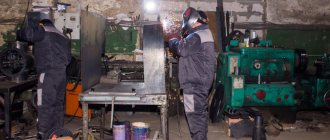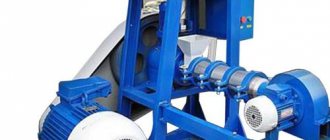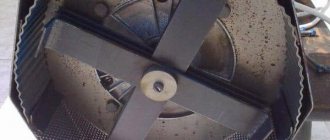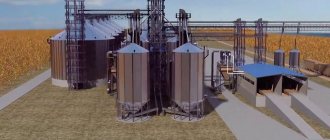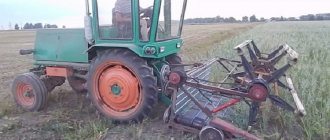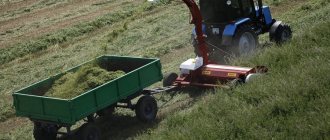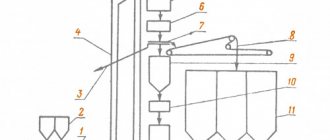Structure of a grain crusher
A household grain grinder consists of several units, the uninterrupted operation of which guarantees the proper operation of all equipment. Regardless of the dimensions, factory features and operational capabilities, the grain crusher consists of the following elements:
- support frame - a vibration-resistant metal structure on which the power unit and other factory components are supported;
- the engine is the basis of the design. The electric motor of the unit creates a force that is sufficient for high-quality crushing of grain crops and waste of natural origin. There are shredders on the market that are equipped with motors with a power of 1.5 kW and higher. A fairly powerful crusher is capable of processing large volumes of grain. However, it is important to remember that as power increases, the amount of electricity consumed by household equipment increases;
- casing for the power unit - protects the operator from burns and the engine itself from the ingress of grain residues into it;
- bunker – a metal container into which grain and waste are poured for processing;
- cutting knives - as a rule, are installed directly on the shaft of the standard power unit. These elements are responsible for uniform grinding of products of natural origin;
- reflector – in the factory design, located in the lower part of the working chamber;
- sieve - an element necessary for sifting the finished crushed grain;
- power cable with plug for connection to the electrical network.
The operating principle of the grain crusher is as follows:
- First, the operator pours grain into a metal bin;
- After connecting to the mains and pressing the start button, the electric motor is activated;
- Simultaneously with the rotation of the power unit shaft, the cutting knives are activated;
- During their circular movement, the working bodies evenly crush the grain and waste poured into the hopper;
- The crushed product passes through a sieve into a container prepared by the operator.
The grain crusher operates cyclically. That is, the grinding process is continuously repeated with each new stroke of the electric motor.
Types of home grain crushers - features of different types of equipment
Grain grinders can be domestic or industrial. Units of the second type are distinguished by their large dimensions, extremely high productivity and the ability to process coarse, unrefined product without harm to their working mechanisms.
A household shredder is a small-sized, narrow-profile equipment. It is capable of processing only pre-cleaned grain with a low percentage of husk. However, domestic crushers are a good option for households. They make it possible to obtain relatively large volumes of crushed grain without significant physical effort from their owners.
Depending on their design features, household and industrial shredders are divided into the following types:
- hammer - are distinguished by their simple design and ease of maintenance. The hammer crusher for grain is equipped with cutting elements located directly on the rotor, which rotates inside the standard receiving chamber;
- rotary – this type of household equipment is one of the most popular on the market. The impact crusher is equipped with durable metal cutting elements, which, during their rotation, hit the walls of the receiving chamber. As a result, the operator is able to obtain a large amount of carefully crushed grain and waste of natural origin;
- disk - in the design of this equipment for the home, the cutting elements are attached to the shaft using special built-in disks. This increases the strength of the unit and allows it to process solid products;
- roller – these units are designed not only for crushing, but also for grinding grain crops. The roller crusher is equipped with grooved rollers that can thoroughly crush the pre-wetted product.
Garden grain grinders are divided among themselves according to the type of working drive:
- manual - the simplest units. The manual crusher is suitable for processing small volumes of prepared grains. It is not equipped with an engine, so the cutting knives of the equipment are driven under the influence of the operator’s physical efforts. The manual type includes a coarse grain crusher, which is not capable of grinding grain into small fractions;
- pneumatic - most often used for crushing corn and other types of grains. This type of equipment works quite quickly and helps turn a whole product into a finished porridge that can be used to feed small poultry and young cattle;
- electric - units of this type are distinguished by their simplicity of design and relatively high performance. A home electric crusher works equally effectively with dry and wet grain.
Among farmers who own small and medium-sized farms, electric rotary choppers are the most popular. They can be sold with both standard and milling-turbine knives. The second option shows a higher speed and decent grinding quality, regardless of the condition and size of the grain.
Roller grain crusher or hammer crusher, pros/cons
Every livestock breeder knows the proverb “What’s on a cow’s tongue is in her milk.” If we speculate on folk wisdom, we can say that it is true for any species of animal. The better quality the feed is prepared, the better it is digestible, the higher the production of agricultural products.
There are a great variety of machines for preparing feed. Today we will compare hammer and roller grain crushers. Both types of machines are very common, although in Russia they still give preference to hammer machines due to their low cost compared to roller machines. But is it worth saving on the purchase price of equipment?
A clear “yes” answer is appropriate if two different types of equipment, as a result of their work, can create an absolutely identical finished product. In our case, unfortunately, this is impossible simply due to the technological differences between the hammer and roller crushers. These technological differences are due, first of all, to the design of the working element and the operating principle of the machine.
The working body of a hammer crusher is a rotor with movable hammers attached to it, which, when the rotor rotates, strike the walls of a drum equipped with holes. The grain is destroyed and squeezed out through the holes of the drum. By changing the drum with different hole diameters, the operator can adjust the structure of the crushed grain mass.
The working body of a roller crusher is two rollers that crush the grain, rotating towards each other. The amount of grain crushing is regulated by changing the working gap between the rollers.
And here we have two machines in front of us, working on completely different principles, but called by the same word “crusher”. The main difference between these machines, of course, lies in the structure of the final product. Grain prepared by a hammer mill contains a huge amount of flour dust. As a result of feeding animals feed with a high content of flour dust, they develop respiratory diseases, and in ruminants, also rumen acidosis. And from sick animals you will not only not get products, but you will also not get high-quality meat.
When using a roller crusher, the picture is completely different, especially if the crusher rollers rotate at different speeds, as is implemented, for example, in ROmiLL crushers. In this case, the teeth of the faster roller cut off part of each grain and push it into the finished product hopper. The conditions for dust formation with this technology are minimal. Therefore, it is not present in processed grain. That is, by choosing a roller crusher, you get maximum quality of crushed grain with minimal waste and a healthy, productive livestock.
But that's not all the benefits. To minimize the negative consequences of using a hammer crusher, manufacturers of equipment of this type are forced to build aspiration units into their crushers, the main task of which is to remove flour dust from the processed heap. For this purpose, a powerful exhaust fan is built into the crusher. Some of the dust is, of course, removed in this way. But not all of it. But the amount of electricity consumed by the aspiration system must be paid in full by the owner. And if you compare the power of the electric motor of a roller crusher with that of a hammer crusher, the difference is more than decent. Energy savings when operating a roller machine can reach 70%! And this is a lot.
This is how it turns out that the “advantages” of a hammer crusher include only its relatively low purchase price. For all other aspects of use, including the cost of owning a crusher, the advantages remain on the side of the roller grain grinding technology. Consequently, over the course of several years of using the roller crusher, it will not only cover the difference in the purchase price, but will also earn additional profits, which a prudent owner can use to develop his own business.
How to choose a grain crusher?
When purchasing a grain grinder, a farmer needs to carefully study its main parameters.
These include:
- purpose - this factor depends on the size of the farm in which the chopper will be used. For small farms, the best option would be to purchase small manual or pneumatic crushers, as well as make a homemade unit. Owners of medium and large farms should think about purchasing electric choppers, which are equipped with regulators for grain grinding size and other necessary functions;
- power - this parameter should be enough to process a sufficient amount of grain. The larger the number of cattle and poultry for feeding, the higher the power of the equipment should be;
- volumes of processed grain - the productivity of the crusher directly depends on its power. Shredders with high productivity will be effective in medium and large farms. Units with low productivity are best purchased to provide sufficient feed for a small number of livestock;
- the need for regular maintenance – every chopper needs timely maintenance. However, manual and pneumatic crushers for small farms require periodic maintenance much less frequently than electric units;
- Suitability for self-repair - the buyer must ensure that he has the opportunity to independently replace failed crusher spare parts. Otherwise, planned equipment repairs will be quite expensive;
- manufacturer - it is best to choose shredders from well-known brands. These include crushers of the Shmel, Elikor, Kolos and Khryusha brands. Any Chinese crusher will show high efficiency and speed only in the first year of its operation. After the warranty period expires, models from China quickly break down and do not demonstrate the required performance even after major repairs.
When choosing a household crusher, you need to carefully examine the attachment points of its mechanisms, the quality of the factory paint and the condition of the materials of its standard elements. Only after making sure of the high quality of assembly and reliability of the unit can we say that it will serve on the farm for as long as possible.
Rating of the best grain crushers
| Nomination | place | Name of product | price |
| Rating of the best grain crushers | 1 | Zubrenok-Mais | 7 393 ₽ |
| 2 | ZUBR-2 | 7 590 ₽ | |
| 3 | Umnitsa Don KBE-180 2.5 kW | 7 450 ₽ | |
| 4 | Cyclone IZKB-2 | 5 542 ₽ | |
| 5 | FARMER IZE-25M | 4 140 ₽ | |
| 6 | Greentechs IZ-05 (170kg/hour) | 2 950 ₽ | |
| 7 | UralSpetsMash IZ-14 (Farmer 300) | 3 630 ₽ | |
| 8 | Whirlwind ZD-400K | 3 080 ₽ | |
| 9 | Electromash Khryusha 300 kg/h | 2 385 ₽ |
Zubrenok-Mais
Rating: 4.9
The Zubrenok-Mais grain crusher will be an excellent purchase for livestock farmers. The model perfectly combines the qualities of a feed cutter and sheller. Therefore, choosing this expensive model subsequently turns out to be a cost-effective purchase. The manufacturer equipped the equipment with a chopper with a hulling machine, two bins (for grain and corn), two dampers, and two meshes with different perforations. Experts pay attention to the efficiency of the electric motor (1.35 kW), which can grind 140 kg of grain in an hour or peel 800 kg of corn. There will be no problems with moving the grain crusher.
Users are satisfied with the functionality of the unit, quick payback, and ease of use. The model becomes the winner of our rating.
Advantages
- good performance;
- ease of use;
- compactness;
- reliability and durability.
Flaws
- not detected.
ZUBR-2
Rating: 4.8
The Russian grain crusher ZUBR-2 has wide functionality. In addition to grinding grains, the model is capable of grinding root vegetables and cutting green mass. The manufacturer equipped its product with a powerful electric motor (1.8 kW), positioning it horizontally. Thanks to this design solution, it was possible to reduce the load on the shaft, which had a positive effect on the durability of the equipment. Experts appreciated the performance of the unit; in an hour it can process 180 kg of grain or 650 kg of root crops. The grinding size is selected by installing a sieve with a cell of 2.5x2.5 or 5x5 mm.
The model takes an honorable second place in the ranking for its versatility and affordable price. Disadvantages include juice getting on the bearing.
Advantages
- multifunctionality;
- affordable price;
- good performance;
- durability.
Flaws
- poor sealing of the chamber.
Umnitsa Don KBE-180 2.5 kW
Rating: 4.7
It is convenient to prepare a tasty feed mixture for pets using the Umnitsa Don KBE-180 grain crusher. The equipment is designed for grinding grains, legumes and root crops. The model is driven by a single-phase electric motor with a power of 2.5 kW. In an hour, the grain crusher is capable of processing up to 200 kg of grain and beans. The user is given the opportunity to select the appropriate grind size by varying the three sieves. Experts note the high build quality and long service life of the equipment. The unit is in the top three of our rating.
Users have positive emotions about the rigidity of the structure, durable paintwork and lack of vibration. As for the disadvantages, the main one will be the high starting current.
Advantages
- great resource;
- good performance;
- robust design;
- ease of use.
Flaws
- high starting current.
Cyclone IZKB-2
Rating: 4.6
The Cyclone IZKB-2 grain crusher has become a popular grinder of feed for poultry and livestock among farmers. The model attracts attention with its affordable price and efficient operation. Not only grain crops, but also root crops are subject to processing. The equipment is driven by a 1.8 kW electric motor. In one minute, the unit grinds up to 5 kg of grain or 11 kg of root crops. Experts liked the design of the feed chopper, where the knife drum plays one of the main roles.
The model stopped one step away from the pedestal of our rating. The position was influenced by feedback from farmers, which pointed out a number of minor shortcomings. For example, during operation the damper closes spontaneously due to vibration. We have to come up with a reliable clamp.
Advantages
- affordable price;
- good performance;
- quality materials;
- reliability.
Flaws
- minor modifications required.
FARMER IZE-25M
Rating: 4.5
The grain crusher FARMER IZE-25M was developed based on the wishes of domestic agricultural producers. The model turned out to be strong and durable; in some farms it lasts about 5 years. The manufacturer offers users several grinding options, starting from 4 mm and ending with 6 mm. Although the equipment is equipped with a small motor (1.3 kW), it has good performance (400 kg/hour). Experts gave the grain crusher the 5th position in the rating.
Users are generally satisfied with the reliability, performance and durability of the unit. It crushes grain efficiently and breaks quite rarely. The model has a number of minor drawbacks. Dissatisfaction is caused by loud noise during grinding, inconvenience of installing the receiving container, and peeling paint.
Advantages
- affordable price;
- reliability and durability;
- high-quality grinding;
- compact sizes.
Flaws
- paint peels off;
- high noise level.
Greentechs IZ-05 (170kg/hour)
Rating: 4.4
The Greentechs IZ-05 grain crusher has an unusual design. The bunker is made in the form of a funnel cut in half. This model is produced at the domestic enterprise ElectroMash. The unit is addressed to peasants with a small number of animals or birds. Only about 5 liters of grain can be loaded into the bunker, and the 1.25 kW electric motor provides a productivity of 170 kg/h. In addition to grains, it is possible to chop any vegetables. Experts liked the compactness and mobility of the grain crusher. With a weight of 7.6 kg and the presence of a convenient handle, moving it to a neighboring area will not be difficult.
The equipment is assembled with high quality, as evidenced by consumer reviews. The only serious drawback that affected the place in our rating was the short electrical cord.
Advantages
- lightness and compactness;
- good performance;
- multifunctionality;
- low price.
Flaws
- short cord.
UralSpetsMash IZ-14 (Farmer 300)
Rating: 4.3
Another compact model made it into our rating. This is a grain crusher UralSpetsMash IZ-14 (Farmer 300). It weighs only 7.7 kg and has compact overall dimensions. Thanks to a spacious loading hopper (14 l) and a 1.2 kW electric motor, the unit processes up to 300 kg of grain per hour. According to experts, the advantages of the product include the ability to regulate the degree of grinding. The device can withstand long grinding times; the design includes bottom and side sieves. The knives are made of hardened steel with a thickness of 0.6 mm, and a spare knife is included in the kit.
Users note the independence and mobility of the unit, quickly obtaining the required grinding. As for the shortcomings, there are cases of engine failure.
Advantages
- compactness and lightness;
- affordable price;
- spacious bunker;
- sharp knives.
Flaws
- engines fail.
Whirlwind ZD-400K
Rating: 4.2
The Vikhr ZD-400K grain crusher can process all types of feed grain. It is important that it be dry, be it wheat or oilseed crops. The model was included in our rating for its lightest weight (5.1 kg). At the same time, it is not inferior to competitors in terms of performance. Thanks to a spacious hopper (14 l) and a powerful electric motor (1.55 kW), it is possible to grind up to 400 kg of grain per hour of operation. The manufacturer allows the installation to be used for 6 hours; pauses of 5-10 minutes should be taken every hour.
Users rate the grain crusher differently. Some owners are satisfied with the performance, while others are unhappy with the stops every hour. Another inconvenience is the need to sift the grain before grinding.
Advantages
- light weight;
- low price;
- high performance;
- sustainability.
Flaws
- the receiving hole is clogged with small stems;
- stops are required every hour.
Electromash Khryusha 300 kg/h
Rating: 4.1
The grain crusher Khryusha 300 kg/h produced by Elektromash is sold at the lowest price. But not only this became the main criterion for getting into our rating. The model is in high demand among domestic peasants. With a small mass of the unit (9 kg), it is capable of grinding up to 300 kg of dry grain per hour. To achieve such performance, the product is equipped with a powerful electric motor (1.75 kW). In the standard version, the model has a sieve with 5 mm cells for obtaining medium-ground grains. The device can be used both indoors and outdoors.
Users praise the grain crusher for its compactness, economical energy consumption, durability and low dust content (up to 5%). The disadvantages include a short cord and lack of adjustment of the degree of grinding.
Advantages
- efficiency;
- reliability;
- ease of use;
- low price.
Flaws
- short cord;
- The degree of grinding is not adjustable.
How to make a grain crusher with your own hands?
Most branded small-sized grinders are quite expensive, so in some cases it is easier and cheaper for farmers to make a grain crusher at home. Subject to careful preparation for manufacturing and the correct sequence of actions during assembly, the designer will be able to assemble a unit that, in terms of efficiency and performance, will be almost as good as proprietary models produced by well-known brands.
To make a grain crusher yourself, the manufacturer will need a diagram. The drawings should tell the designer in what order and in what way to fasten the elements and working mechanisms of the unit.
You can use an old working vacuum cleaner as the basis for a homemade shredder.
The procedure for manufacturing household equipment should be as follows:
- To assemble the shredder base, the manufacturer will need a sheet of thick plywood. From it you need to cut a square with dimensions of 30x30 cm. You need to install an electric motor from a vacuum cleaner on the finished base. In this case, the standard motor shaft should protrude approximately 4 cm downwards above the edge of the plywood;
- The cutting parts of a homemade shredder are pre-sharpened knives that will crush grain and waste. To assemble it, the manufacturer will need a steel plate 1.5 cm high, 20 cm long and 1.5 cm wide. Both front edges of the knife must be sharpened towards the axis. In the middle part of the element you need to drill a through hole, the diameter of which should correspond to the thickness of the electric motor shaft from the vacuum cleaner. The finished knife will need to be fixedly attached to the shaft;
- To make the working chamber of the crusher, it is necessary to use a metal strip no more than 6 cm wide and about 71 cm long. An additional centimeter of strip length is needed taking into account its fixation in the overall design of the homemade product. To install the grain grinder at the bottom of the working chamber, the manufacturer will need 3 wooden or metal rods;
- The mesh for a homemade crusher should be selected taking into account the purpose of the crusher. If the operator needs to process grain into fine flour, then the mesh cells should be of small diameter. If a farmer needs to grind feed, then the size of the cells must be increased. To collect crushed grain, you will need to install a clean bucket or any other container under the sieve;
- Finally, the manufacturer will need to install a receiving hopper for the crusher. It can be made from a large metal or plastic container. You need to install the bunker at the base of a homemade grain crusher. In order for the operator to regulate the supply volumes of natural products, a hole with a manual shutter must be made in the lower part of the tank.
A ready-made homemade grain crusher will show high efficiency when processing corn, oats, wheat and other grain crops. Depending on the power of the motor used by the vacuum cleaner, its productivity will range from 5 to 10 kg of product per 1 hour of operation.
